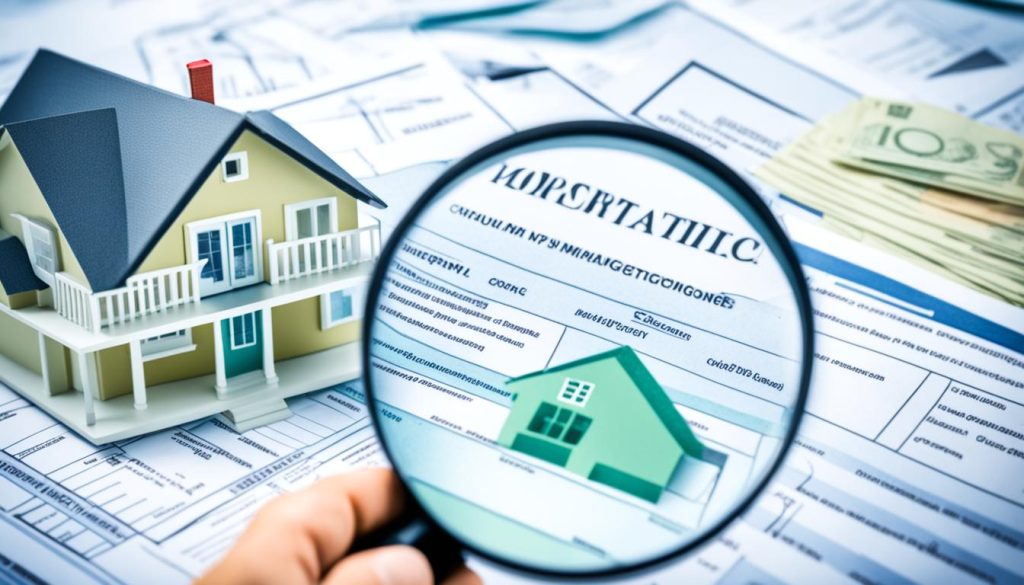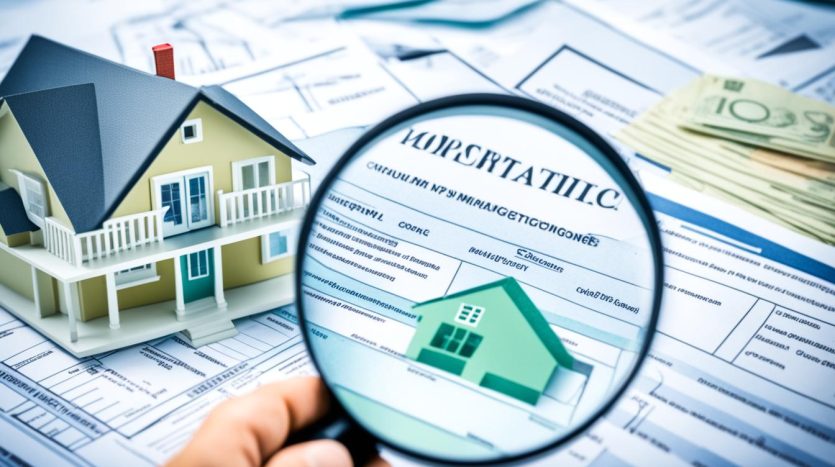Discovering the Best Mortgage Option for You
Did you know that the total value of U.S. mortgage debt reached a staggering $11.2 trillion in 2022? With so many mortgage options available, selecting the right one can be a daunting task for homebuyers. From fixed-rate mortgages to government-backed loans, the choice you make can significantly impact your monthly payments, down payment, and overall financial situation.
Whether you’re a first-time homebuyer or an experienced real estate investor, understanding the mortgage landscape is crucial. Fixed-rate mortgages offer the stability of predictable monthly payments, while adjustable-rate mortgages (ARMs) can start with lower rates but may fluctuate over time. Government-backed loans like FHA, VA, and USDA loans can provide access to homeownership with reduced down payment requirements, but come with their own eligibility criteria.
The down payment, typically ranging from 3-20% of the home’s purchase price, is another important factor to consider. Your monthly mortgage payment will also include interest, principal, and potentially property taxes and homeowners insurance. Consulting with a lending advisor can help you determine the right mortgage for your needs and financial goals.
Key Takeaways
- The U.S. mortgage debt reached $11.2 trillion in 2022, indicating the vast scale of the mortgage market.
- Fixed-rate mortgages offer predictable monthly payments, while adjustable-rate mortgages (ARMs) can have lower initial rates but fluctuating payments.
- Government-backed loans like FHA, VA, and USDA may require lower down payments but have specific eligibility criteria.
- The down payment typically ranges from 3-20% of the home’s purchase price, and the monthly payment includes interest, principal, and potentially taxes and insurance.
- Consulting a lending advisor can help you determine the right mortgage for your unique financial situation and goals.
Understanding Mortgage Basics
Navigating the world of mortgages can be daunting, but understanding the fundamental concepts is crucial for making informed decisions about your home financing. Two key components to consider are the down payment and your monthly payments.
The Down Payment
The down payment is the upfront amount you, as a homebuyer, contribute towards the purchase price of your new home. Typically, this can range from 3% to 20% of the home’s value. The remaining amount is then borrowed from a lender as the principal of your mortgage loan. The size of your down payment can impact the terms of your loan and the overall cost of your monthly payments.
Monthly Payments
Your monthly mortgage payment consists of several components, including interest, principal, and potentially property taxes and homeowners insurance. The interest portion covers the cost of borrowing the money, while the principal represents the amount you’re paying towards the overall loan balance. Understanding these elements can help you determine what you can afford and select the right home financing option for your situation.
Types of Mortgages
When it comes to home financing, there are two primary types of mortgages to consider: the fixed-rate mortgage and the adjustable-rate mortgage (ARM). Understanding the unique characteristics of each can help you make an informed decision that aligns with your long-term plans and financial situation.
Fixed-Rate Mortgage
The most common type of mortgage is the fixed-rate mortgage, where the interest rate remains the same for the life of the loan, typically 15 or 30 years. This provides homebuyers with predictability and stability in their monthly payments, making it easier to budget and plan for the long-term. With a fixed-rate mortgage, your interest rate and monthly payment will not change, even if market rates fluctuate.
Adjustable-Rate Mortgage (ARM)
In contrast, an adjustable-rate mortgage (ARM) has an interest rate that can change periodically, based on market conditions. ARMs may start with a lower interest rate than fixed-rate mortgages, but this rate can increase over time, leading to fluctuating monthly payments. ARMs can be a good option for homebuyers who plan to own the home for a shorter period, as they may benefit from the initial lower rate before the loan adjusts.
Ultimately, when choosing between a fixed-rate or adjustable-rate mortgage, it’s important to carefully consider your long-term plans and financial situation. Consult with a lending professional to determine the mortgage type that best fits your needs and goals.
Government-Backed Mortgage Options
When it comes to home financing, government-backed mortgage options can be particularly attractive for homebuyers with limited savings or specific financial constraints. These government-backed loans, such as FHA, VA, and USDA loans, often provide more accessible paths to homeownership by offering lower down payment requirements, flexible eligibility criteria, and competitive interest rates.
FHA Loan
The Federal Housing Administration (FHA) loan is a popular choice among first-time and low-to-moderate-income homebuyers. FHA loans require a down payment of as little as 3.5% of the home’s purchase price, making them a viable option for those who may not have a substantial amount saved for a larger down payment. These loans also have specific requirements, such as minimum credit scores and debt-to-income ratios, that can be more lenient compared to conventional mortgage options.
VA Loan
The VA loan is an exceptional mortgage program designed for eligible members of the military, veterans, and their spouses. Backed by the U.S. Department of Veterans Affairs, VA loans offer several benefits, including no down payment requirement and no mortgage insurance. This makes them an attractive choice for those who have served our country and are looking to purchase a home.
USDA Loan
The USDA Rural Development loan, as described by the third source, is specifically tailored for homebuyers in rural areas. This government-backed mortgage option can finance up to 100% of the home’s purchase price, with discounted interest rates that make homeownership more accessible for those in qualifying rural communities. The USDA loan is an excellent option for individuals or families seeking to purchase a home in a rural or suburban setting.
While these government-backed mortgage options offer unique advantages, it’s important for homebuyers to carefully review the eligibility criteria and requirements to ensure they select the loan that best fits their financial situation and long-term goals.
Bridge Loan: Transitioning Between Homes
When purchasing a new home before selling your current residence, a bridge loan, also known as a gap loan or repeat financing, can be a valuable option to consider. These specialized loans allow you to temporarily combine the payments for both homes into a single mortgage, facilitating a more seamless transition between properties.
Bridge loans are particularly well-suited for homeowners with excellent credit, a low debt-to-income ratio, and the ability to finance no more than 80% of the combined value of the two homes. This type of loan can provide a financial solution for those who need to move but want to avoid the burden of carrying two separate mortgages simultaneously.
The bridge loan can be a practical choice for homeowners in the midst of a home transition, bridging the gap between the sale of their current home and the purchase of their new one. By leveraging repeat financing through a gap loan, you can maintain financial flexibility and focus on finding your dream home without the added stress of managing two mortgage payments.
It’s important to note that bridge loans are typically more expensive than traditional mortgages, with higher interest rates and additional fees. However, for those in need of a seamless home transition, the benefits of a bridge loan may outweigh the increased costs, providing a valuable solution during the repeat financing process.
Mortgage Rates and Your Financial Situation
Choosing between a fixed-rate mortgage or an adjustable-rate mortgage (ARM) can have significant implications for your financial situation and long-term plans. Understanding the nuances of these mortgage types is crucial in selecting the right option for your unique circumstances.
Fixed-Rate vs. Adjustable-Rate Mortgages
Fixed-rate mortgages offer stability and predictability, with the same interest rate for the life of the loan. This can provide peace of mind and allow for better budgeting, as your monthly payments will remain constant. On the other hand, ARMs may start with lower rates, but these rates can fluctuate over time, leading to potentially higher payments in the future.
Considering Your Long-Term Plans
When deciding between a fixed-rate or adjustable-rate mortgage, it’s essential to consider your long-term plans. Fixed-rate mortgages are typically better suited for homebuyers who intend to stay in their home for a longer period, as they offer stability and predictability. ARMs, however, may be advantageous for those who expect to move within the initial fixed-rate period, as the lower starting rates can provide more flexibility and potential savings.
Carefully evaluating your mortgage rates, financial situation, and long-term plans will help you determine the most suitable fixed-rate mortgage or adjustable-rate mortgage for your needs, ensuring a solid foundation for your homeownership journey.
Mortgage Pre-Approval and Pre-Qualification
Before embarking on the home buying process, it’s crucial to understand the importance of getting mortgage pre-approved or pre-qualified. These steps can provide valuable insights into your home financing capabilities and help you make more informed decisions.
Mortgage pre-approval involves a thorough review of your financial information, including your credit score, income, and debt. This comprehensive assessment allows lenders to determine the maximum loan amount you may qualify for, giving you a clear understanding of your home buying budget. By obtaining pre-approval, you’ll be better positioned to navigate the home buying process with confidence and clarity.
On the other hand, mortgage pre-qualification is a less intensive process that provides an estimate of the loan amount you may be able to borrow. While not as comprehensive as pre-approval, pre-qualification can still be a valuable tool in understanding your home financing options and helping you focus your search on properties within your price range.
The third source encourages homebuyers to consult with a lending expert to determine the best approach for their specific situation. By understanding the differences between pre-approval and pre-qualification, you can make an informed decision that aligns with your financial goals and home buying timeline.

Factors Affecting Your Mortgage Eligibility
When it comes to securing a mortgage, lenders carefully evaluate several key factors to determine a homebuyer’s eligibility. Understanding these critical elements can help you prepare and improve your chances of obtaining the best mortgage terms for your home financing needs.
Credit Score
Your credit score is a crucial factor in the mortgage eligibility equation. Lenders use this three-digit number to assess your creditworthiness and the likelihood of you making timely mortgage payments. Maintaining a high credit score can significantly boost your chances of securing favorable loan terms and interest rates.
Debt-to-Income Ratio
Lenders also closely examine your debt-to-income ratio, which compares your monthly debt obligations to your monthly income. This metric helps them gauge your ability to manage your mortgage payments alongside your other financial commitments. Maintaining a low debt-to-income ratio can demonstrate your financial stability and increase your chances of mortgage approval.
Employment History
In addition to your credit and debt profile, lenders will also consider your employment history and stability. A steady job with a consistent income stream can indicate your capacity to make consistent mortgage payments over time. Demonstrating a solid employment history can further enhance your mortgage eligibility and help you secure the best financing options.
By understanding these key factors that influence mortgage eligibility, you can take proactive steps to prepare and position yourself for a successful home financing experience. Focusing on maintaining a strong credit score, managing your debt responsibly, and providing evidence of your employment history can significantly improve your chances of securing the mortgage that best aligns with your home financing goals.
Closing Costs and Additional Fees
When purchasing a home, homebuyers should be aware of the various closing costs and additional fees that come along with the home buying expenses and mortgage costs. Closing costs typically include items like loan origination fees, appraisal fees, title insurance, and other third-party expenses. These costs can significantly impact the overall financial investment required to secure a new home.
According to the third source, it is crucial for homebuyers to carefully review and understand these additional fees to ensure they have a complete understanding of the total cost of homeownership. Budgeting for these expenses, in addition to the down payment and monthly mortgage payments, is essential for homebuyers to make informed decisions and avoid unexpected financial burdens.
| Closing Cost Category | Typical Cost Range |
|---|---|
| Loan Origination Fee | 0.5% – 1% of the loan amount |
| Appraisal Fee | $300 – $600 |
| Title Insurance | 0.5% – 1% of the home’s value |
| Escrow Fees | $300 – $800 |
| Recording Fees | $50 – $150 |
By understanding the various closing costs and additional fees associated with the home buying expenses and mortgage costs, homebuyers can better plan and budget for the total financial investment required to purchase their dream home.
The Mortgage Application Process
Navigating the mortgage application process can involve several steps and require various required documentation from homebuyers. To ensure a smooth and efficient experience, it’s crucial to be prepared with all the necessary paperwork before starting the application.
Required Documentation
Typical required documentation for a mortgage application may include proof of income, such as pay stubs, W-2 forms, and tax returns; employment history; asset statements, including bank accounts and investment portfolios; and detailed credit history. Lenders will thoroughly review this information to assess the borrower’s creditworthiness and ability to make timely mortgage payments.
Loan Processing Timeline
Once the lender has received and reviewed all the necessary documentation, the loan processing timeline can take several weeks to complete. During this time, the lender will verify the information, order an appraisal of the property, and work to secure final loan approval. The home buying process can be streamlined by staying in close communication with the lender and understanding the expected timeline for the mortgage application and closing.

By being prepared with the required documentation and working closely with the lender, homebuyers can help ensure a more efficient and stress-free mortgage application process. This can ultimately lead to a smoother home buying process and a successful transition into homeownership.
Mortgage Refinancing Options
As a homeowner, you may be considering refinancing your mortgage to potentially lower your interest rate, shorten your loan term, or access the equity in your home. Two common refinancing options to explore are cash-out refinancing and rate-and-term refinancing.
Cash-Out Refinancing
Cash-out refinancing allows you to replace your existing mortgage with a new loan for more than your current balance, enabling you to access the equity you’ve built up in your home. This can provide you with a lump sum of cash that you can use for a variety of purposes, such as home improvements, debt consolidation, or other financial needs. However, it’s important to carefully consider the costs and potential risks associated with this type of refinancing, as it may increase your overall mortgage debt and monthly payments.
Rate-and-Term Refinancing
Another option is rate-and-term refinancing, which involves replacing your current mortgage with a new loan that has a different interest rate and/or loan term. This can be a useful strategy if you’re looking to lower your monthly mortgage payments or shorten the length of your loan. By securing a lower interest rate or adjusting the loan term, you may be able to potentially save money over the life of your mortgage. Rate-and-term refinancing may be particularly attractive if you plan to stay in your home for the foreseeable future.
When considering your mortgage refinancing options, it’s essential to evaluate your financial goals, the equity in your home, and the potential costs and benefits of each option. Consulting with a trusted mortgage professional can help you determine the best refinancing strategy to suit your needs and long-term plans.
Mortgage Calculators and Resources
As you navigate the mortgage process, you’ll find a wealth of online tools and resources to help you make informed decisions. Mortgage calculators, for instance, can be invaluable in estimating your monthly payments, determining your borrowing capacity, and comparing different loan options. By utilizing these mortgage calculators, you can gain a clear understanding of how various factors, such as interest rates and loan terms, may impact your overall financial situation.
In addition to calculators, there are numerous mortgage resources available that can provide you with valuable information and guidance throughout your home buying journey. These resources may include educational articles, guides, and even interactive learning modules that cover everything from the basics of mortgages to more advanced topics like government-backed loan programs and refinancing strategies. Exploring these home financing tools can help you feel more confident and well-equipped as you navigate the complexities of the mortgage process.
As you embark on your home buying journey, don’t hesitate to lean on the expertise of mortgage lenders and real estate professionals. These industry experts can offer personalized homebuyer information and support, guiding you through each step of the process and ensuring you make the best decisions for your financial goals and long-term plans. By leveraging the wealth of resources available, you can make more informed choices and take control of your mortgage financing journey.



